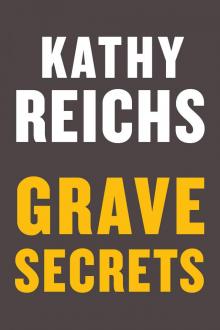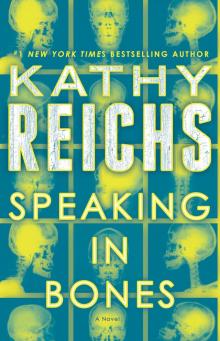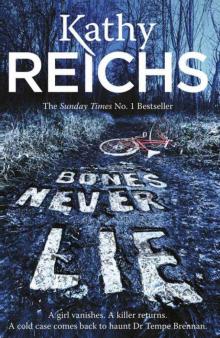- Home
- Kathy Reichs
Deadly Descisions Page 8
Deadly Descisions Read online
Page 8
As soon as I'd finished with the skulls and jaws I'd given them to Marc Bergeron for odontological analysis. I figured his job would be easy too, since both men had obvious dental work.
The taller victim had a well-healed fracture of the collarbone. I was photographing the injury when Bergeron entered my lab Friday morning. The dentist was one of the oddest-looking men I'd ever met, with wild, dandelion hair and a daddy-longlegs build. It was impossible to guess his age, and no one at the lab seemed to know.
Bergeron waited until I'd snapped the shot then confirmed the identifications as positive.
"How did you get the records so quickly?"
"Two very cooperative dentists. And, fortunately for me, the deceased had a commitment to oral health. At least Gately did. Bad teeth, lots of restorations. Martineau was less fastidious, but there were some peculiarities that made him a cinch. The big bad biker was walking around with four baby teeth in his mouth. That's pretty rare for someone his age.
I turned off the lights on the copy stand.
"Have you started on the third victim?" Bergeron asked.
"Not yet, but I can finish this later Shall we take a look?"
I'd been wanting to look at the third set of bones all morning and Bergeron provided a good excuse.
"You bet."
I returned the collarbone to the skeleton on the left side of my worktable.
"Who's who?" I asked, gesturing at the bones.
Bergeron went to his tray and checked the digits on each occipital bone, then those on the small cards I'd set beside the skeletons, and positioned the skulls accordingly. He swept a bony arm over the victim with the broken clavicle.
"Monsieur Martineau."
Then over the gentleman on his right.
"And Mr. Gately."
"Was Gately an Anglophone?"
"I assume so since his dentist doesn't speak a word of French."
"Not too many of those among les mot4rds."
"None that I know of," Bergeron agreed.
"Will you give the good news to Quickwater and Claudel?"
"I've already made the call."
I went to the storage shelves and pulled the box containing the third St-Basile victim. Since the remains were coated with dirt, I placed a screen in the sink, set them in it, and ran warm water over them.
The long bones cleaned easily, so I laid them on the drainboard and began brushing mud from the outside of the skull. Its weight told me that the cranial interior was packed solid. When the facial features were clear I inverted the skull and let the tap water run over the base. Then I crossed to my desk to fill out a case identification card.
When I returned to the sink Bergeron held the skull in his hands, turning it faceup, then rotating it for a lateral view He stared at the features a long time then said, "Oh my.
When he handed me the cranium I repeated his movements, then echoed his thought.
"Oh my"
Chapter 11
One look and I knew I'd been wrong. The smooth forehead and occiput, slender cheekbones, and small mastoid processes told me that bachelor number three was clearly of my own gender.
I got my calipers and took a measurement from one of the bones that lay on the drainboard. The femoral head is a ball-like structure that fits into a socket in the pelvis to form the hip joint. This one had a diameter of only thirty-nine millimeters, placing it squarely in the female range.
And the victim had been young. I could see a jagged line across the top of the ball, indicating that fusion of the growth cap was incomplete at the time of death.
I returned to the cranium. Squiggly lines separated all the bones. I rotated the skull for a view of the base. Just in front of the foramen magnum, the hole through which the spinal cord leaves the brain, there was a gap between the sphenoid and occipital bones.
I showed Bergeron the open suture.
"She was just a kid," I said. "Probably in her teens."
He made a comment, but I didn't hear. My attention had been drawn to an irregularity on the right parietal bone. Cautiously, I ran my fingers over it. Yes, there was something there.
Taking care to cause no damage, I held the skull under the faucet and teased away dirt with a soft-bristle toothbrush. Bergeron watched as the defect came into focus. It took only moments.
What I'd spotted was a small round hole, slightly above and behind the ear opening. I estimated its diameter at approximately one centimeter.
"Gunshot wound?" Bergeron suggested.
"Maybe. No. I don't think so."
Though the proper size for a small-caliber projectile, the perforation didn't look like a bullet entrance. Its border was smooth and rounded, like the inside of a doughnut hole.
"Then what?"
"I'm not sure. Maybe some type of congenital defect. Maybe an abscess. I'll know better when I empty the skull and get a look at the endocranial surface. I'll also need IX rays to see what's going on inside the bone."
Bergeron looked at his watch.
"Let me know when you've finished so I can shoot some bitewings on this one. I didn't see any restorations, but I might spot something on the X rays. The right canine has an odd alignment which will be useful, but I'd prefer having the lower jaw."
"I'll work harder next time.
"Not necessary." He laughed.
When Bergeron left I set the skull upside down in a rubber ring and adjusted the water so it ran gently into the foramen magnum. Then I went back to photographing Gately and Martineau, documenting skeletal features relevant to their identifications. I also took multiple shots of the bullet holes in the back of each man's head.
Periodically I checked the unknown female's skull, pouring off muck as the water Joosened it. Just before noon, as I was draining sediment, something broke free and tapped against the cranial interior I placed the skull back on the ring and slipped my fingers inside.
The object felt long and thin. I tried to dislodge it, but the thing had a tail of some sort still embedded in the mud. Barely able to contain my curiosity, I adjusted the tap and went back to the Gatcly report.
By 1 P.M. the object floated free, but the trailer was still firmly cemented. Impatient, I allowed the sink to fill, immersed the skull, and went downstairs to the cafeteria.
When I returned from lunch the soaking had liquefied the last of the dirt, and I was able to pour it off easily. Holding my breath, I inserted my fingers and delicately manipulated the object free.
The device was less than four inches long, and consisted of a length of tubing with a valve at one end. I cleaned it and placed it on a tray. Certain of its importance, but unsure as to what it was, I washed my hands and went in search of a pathologist.
According to the duty board, LaManche was at a meeting of the committee on infant mortality. Marcel Morin was at his desk.
He looked up when I tapped on the door.
"Got a minute?"
"But of course." His French was warm and lyrical, reflecting the Haiti of his boyhood. I entered the office and placed the tray in front of him.
"Ah. a surgical implant." His eyebrows rose behind rimless glasses. They were graying, like the tightly cropped frizz of hair retreating backward on his scalp.
"I thought so. Can you tell me more about it?"
He lifted both palms. "Not much. It looks like a ventricular shunt, but I'm not a neurosurgeon. You might want to talk to Carolyn Russell. She's done some neuro consults for us."
He flipped through his Rolodex, jotted down a number, and handed it to me, saying, "She's at the MNI."
I thanked him, went to my office, and dialed the Montreal Neurological Institute. Dr. Russell was in a meeting, sol left a message. I'd just hung up when the phone rang. It was Claudel.
"You've talked to Bergeron?" he asked.
"He just left."
"So two make the jump from the list of missing to the list of dead."
I waited for him to go on, but he didn't.
'And?"
A
Claudel pause, then, "We've started making calls, but no one knows a thing. Not surprising, given the fact that more than a decade has passed and these people aren't geographically stable. Of course they wouldn't tell us spit if we'd hauled their grandmothers out of that hole."
"What about Rinaldi?"
"Frog's sticking to his story. He knew what he knew by word of mouth. According to club lore Gately and Martineau went to a party and walked right in on their own funeral."
"In stocking feet."
"Right. These fellows tend to underdress. But Frog wasn't there when the hit went down. It was probably his night for charity work. What about the third guy?"
"The third guy is a girl."
"A girl."
"Yes. What does Frog know about her?"
"Not a thing. But Frog would give nothing up if there wasn't a prize in it for him. What can you tell me about her?"
"She was a white female in her mid to late teens.
"She was that young?"
"Yes."
I could hear traffic in the background and figured Claudel was calling from the road.
"I'll get a list of missing teenage girls. What time frame?"
"Go back ten years.
"Why ten years?"
"I'd say the victim's been dead at least two years, but with what we recovered I can't really pinpoint an upper limit. I have a feeling this was a secondary burial."
"What does that mean?"
"I think she was buried somewhere else, then dug up and moved to the place we found her."
"Why?"
"Another perceptive question, Detective Claudel."
I told him about the surgical implant.
"What does that mean?"
"When I find out I'll let you know"
I'd hardly replaced the receiver when the phone rang again. Carolyn Russell could see me at three. I looked at my watch. If the parking gods smiled I could make it.
I wrote the case number on the lid of a plastic specimen container and sealed the implant inside. Pausing only to tell Bergeron that he could have the girl's skull, I hurried to my car and raced across town.
The Royal Victoria Hospital was built before the turn of the century. A sprawling gray stone complex, it lies in the heart of Montreai, looming over the McGill campus like a medieval castle on a Tuscan hillside.
At the Peel end is the Allan Memorial Institute, infamous for CIA drug experiments conducted there in the late fifties. The Montreal Neurological Institute is located to the east of the Royal Vic, across rue Université. Teaching and research units of McGill University, the MNI, the Neurological Hospital, and the new Brain Tumor Research Institute sit haunch to jowl with the football stadium, a testimonial in mortar and brick to the priorities of the modern university.
The Neuro, as the research institute and hospital are known, dates to the thirties, the brainchild of Wilder Penfield. Though a brilliant scientist and neurosurgeon, Dr. Penfield was not a visionary in traffic control. Parking is a nightmare.
Following Dr. Russell's suggestion, I drove onto the grounds of the Royal Vic, forked over ten dollars, and began cruising the lot. I was on my third pass when I spotted brake lights. An Audi pulled out and I shot forward and into the space, thus avoiding the necessity of tuning to FM 88.5 for a parking update. My watch said two fifty-five.
I arrived at Russell's office sweaty and panting from my dash down avenue des Pins and my trek through the hospital. It had begun to mist, and my bangs lay damp and limp across my forehead. When the doctor looked up, an expression of doubt crossed her face.
I introduced myself and she rose and held out a hand. Her hair was gray, cut short and swept to the side. Her face was deeply creased, but her grip was as strong as that of any man. I guessed she was somewhere in her sixties.
"Sorry I'm late. I had a little trouble finding you." That was an understatement.
"Yes, this building is confusing. Please sit down," she said in English, gesturing at a chair opposite her desk.
"I had no idea this place was so large," I said, seating myself.
"Oh yes. The MNI is engaged in an enormous range of activities.
"I know the institute is world famous for its epilepsy research." I slipped off my jacket.
"Yes, more epilepsy surgeries are performed at our hospital than at any other center in the world. The surgical technique of cortical resection was pioneered at this institution. Studies in the mapping of cerebral function began with epilepsy patients here more than sixty years ago. It was that work that paved the way for the MRI and PET brain mapping going on today."
"I'm familiar with Magnetic Resonance Imaging but what is PET?"
"Positron Emission Tomography. Like MEl, it's a technique used to image brain structure and physiology. Our McConnell Brain Imaging Centre is rated as one of the world's leading facilities."
"What other research do you do?"
"A tremendous amount of groundbreaking work has emanated from the MNI. The development of electroencephalograph', the concept of focal and generalized epilepsies, new methods of frameless stereotactic surgery contributions to postglandin biochemistry in the nervous system, localization of dystrophin skeletal muscle. I could go on and on.
I was certain she could. Dr. Russell was obviously proud of her employer. I smiled encouragement, though I understood only part of what she had listed.
She leaned back and laughed. "I'm sure you are not here for a lecture on the Neuro."
"No, but it's fascinating. I wish I had more time. But I know you're very busy and I don't want to take up any more of your day than necessary.
I took the container from my purse and handed it to her. She looked at it, then unscrewed the cap and slid the implant onto a piece of paper on the blotter of her desk.
"This is an old one," she said, turning it over with a pencil. "I don't think they've made this model for years."
"What is it?"
"It's a ventriculo-peritoneal shunt. They're implanted for the treatment of hydrocephalus."
"Hydrocephalus?" I knew the term, but was surprised to hear her say it. What other misfortunes would I learn about this child?
"It's commonly known as 'water on the brain,' but that's not really accurate, although that's a literal translation from the Greek, hydro being water, and cephalus being head. Cerebral spinal fluid is constantly produced in spaces in the brain called ventricles. Normally it circulates through the four ventricles, and flows over the brain's surface and down the spinal cord. Eventually the CFS is absorbed into the bloodstream, and the amount of fluid and pressure in the ventricles stays within acceptable limits.
"But if drainage is blocked, fluid will accumulate, causing the ventricles to swell and press on the surrounding tissue."
"So hydrocephalus refers to an imbaiance in the amount of CSF produced and the rate at which it drains from the ventricles."
"Exactly."
"And, as the CSF builds up, it causes the ventricles to enlarge and the pressure inside the head to increase."
"You've got it. Hydrocephalus can be acquired or congenital, which is not to say hereditary. The term simply means the condition is present at birth."
"I found the shunt in a normal-looking skull. Doesn't hydrocephalus result in increased head size?"
"Only in infants, and only if left untreated. As you know, with older children and adults the bones of the skull are already formed."
"What causes it?"
"There are lots of reasons for inadequate CSF drainage. Prematurity puts an infant at high risk. And most babies with spina bifida have hydrocephalus."
"Spina bifida involves a neural tube defect?"
"Yes. The problem occurs during the first four weeks of gestation, often before the mother knows she's pregnant. The embryo's neural tube, which develops into the brain, spinal cord, and vertebral column, fails to form properly, leading to varying degrees of permanent damage."
"How common is it?"
"Entirely too common. It's estimated
that spina biflda affects one in every thousand babies born in the United States, and about one in seven hundred and fifty born in Canada."
"I recovered no vertebrae, sol have no way to know if my young lady had spina bifida."
Russell nodded in agreement, then continued her explanation.
"There are many other causes of hydrocephalus besides spina bifida." She ticked them off on her fingers. "It can result from brain hemorrhage. The inflammation and debris resulting from brain infections, such as meningitis, can block drainage pathways. Tumors can cause compression and swelling of brain tissues and result in poor drainage. So can certain types of cysts. And hydrocephalus can be familial."
"It can be inherited?"
"Yes. Though that's rare."
"So where does the shunt come in?"
"There is no way to cure or prevent hydrocephalus. For the past forty years the most effective treatment has been the surgical insertion of a shunt. The one you've brought is a bit outdated, but it's really pretty typical.
"Most shunts are just flexible tubes placed into the ventricles to divert the flow of CSF. They consist of a system of tubes with a valve to control the rate of drainage and to prevent back flow. The early ones diverted the accumulated CSF into a vein in the neck, then into the right atrium of the heart. Those are called ventriculo-atrial, or VA shunts. Some VA shunts are still used, but there are problems associated with them, including infection, and, though rare, heart failure due to blockage of blood vessels within the lungs by particles of blood clot flaking off the shunt's catheter tip. Most shunts now drain into the peritoneal cavity They're called VP shunts."
She indicated the device I'd pulled from the skull.
"This is a VP shunt. In the living patient you would have been able to feel the bottom tube ninning under the skin that overlies the ribs. That part of the device is missing."
I waited for her to go on.
"The peritoneal cavity is large and can usually handle any amount of fluid delivered by the shunt. Another advantage of draining into the abdomen is that the rhythmic contractions of the intestinal organs move the tip of the catheter around. That motion prevents its becoming blocked or sequestered in scar tissue.
"When do these things go in?"

 Two Nights
Two Nights The Bone Collection: Four Novellas
The Bone Collection: Four Novellas Fatal Voyage
Fatal Voyage 206 Bones
206 Bones Bones to Ashes
Bones to Ashes Terminal
Terminal Monday Mourning
Monday Mourning Flash and Bones
Flash and Bones Cross Bones
Cross Bones Devil Bones
Devil Bones Break No Bones
Break No Bones Swamp Bones
Swamp Bones Déjà Dead
Déjà Dead Shock
Shock Spider Bones
Spider Bones Death Du Jour
Death Du Jour Grave Secrets
Grave Secrets Trace Evidence: A Virals Short Story Collection
Trace Evidence: A Virals Short Story Collection Bones on Ice
Bones on Ice The Bone Code
The Bone Code Bones in Her Pocket
Bones in Her Pocket Seizure:
Seizure: Speaking in Bones
Speaking in Bones Deadly Decisions
Deadly Decisions Spike
Spike Bones Never Lie
Bones Never Lie Bones of the Lost
Bones of the Lost Virals 03.5 - Swipe
Virals 03.5 - Swipe Exposure
Exposure A Conspiracy of Bones
A Conspiracy of Bones Shift (tory brennan)
Shift (tory brennan) Bones of the Lost: A Temperance Brennan Novel tb-16
Bones of the Lost: A Temperance Brennan Novel tb-16 Virals tb-1
Virals tb-1 Bones Are Forever tb-15
Bones Are Forever tb-15 Code tb-3
Code tb-3 Seizure tb-2
Seizure tb-2 Deadly Descisions
Deadly Descisions Spider Bones: A Novel
Spider Bones: A Novel